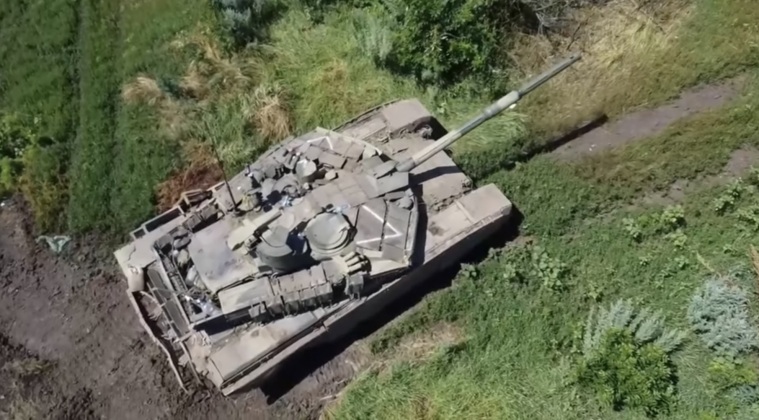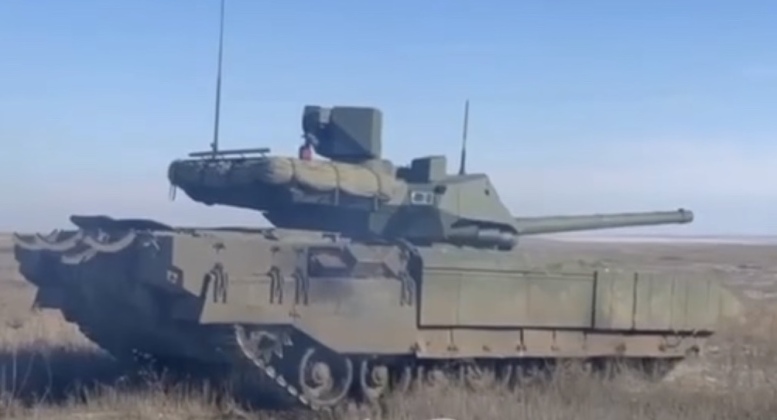News
Former Russian President Reveals Why New T-14 Armata Tanks Not Deployed: Reiterates Praise for T-90M as ‘Best in World’
Russian Security Council Deputy Chairman Dmitry Medvedev on February 22 revealed why the Army had not put the T-14 Armata next generation main battle tank into service in Ukraine. “the Armata is a new tank, which has not yet fully passed all trials,” he stated, emphasising that it was also “not the cheapest of tanks.” Following widespread criticism that the T-14 increasingly appeared to have been developed more for public relations purposes than to provide an actually viable vehicle, Medvedev seemed to partly support this narrative, stating when explaining the lack of T-14 deployments that: “parades are parades, and war is war. These are totally different things.” The T-14 is approaching nine years since it was first unveiled in May 2015, with the defence sector’s inability to provide a tank class ready for operational service having done much to undermine its reputation. This has been even more of an embarrassment when considering that the T-14’s most revolutionary features were largely developed through to completion in the Soviet era under the T-95 program. The T-14 is considered a ‘toned down’ and lower cost successor to the cancelled T-95 which the post-Soviet defence sector has been in a much weaker position to see through to completion than that of the Soviet Union had been.

While explaining the T-14’s absence, Deputy Chairman Medvedev also extensively praised the capabilities of the T-90M tank currently widely operated by the Russian Army. “We have tanks that have proven themselves brilliantly during the special op period – the T-90M ‘Proryv,’ which the president [Putin] called the best tank in the world recently. I would like to fully share this position,” he stated. He added that all his conversations with people involved in operations in Ukraine “prove that this is exactly the case.” He then elaborated: “Battle commanders that come back from the frontline and order equipment, they asked to help with obtaining the T-90Ms. It is a very good weapon.” Medvedev notably previously stated in March 2023: “In my opinion, this [T-90M tank] is now the best tank in the world … It is certainly better than Leopard, Challenger, Abrams [tanks], including in terms of its tactical and technical data, even in terms of such a component as mass.” Similarly strong praise for the tank was given by President Vladimir Putin four months later in July, when he cited a report regarding the T-90M’s durability when hitting a roadside bomb.

The T-90 is an enhanced derivative of the T-72 tank that first entered service in 1973, after it had been developed as a cheaper and lower maintenance counterpart to the Soviet Army’s primary main battle tank the T-64 which had joined the fleet the previous decade. Originally designated T-72BU, the tank was re-designated in the 1990s to reflect its superiority and better market it for export. The latest T-90M variant is by far the most revolutionary iteration of the design, with its firepower, sensors and armour protection placing it in a different league compared to other tanks in the Russian arsenal. Its capabilities are on paper nevertheless considerably behind those of the T-14, which is an entirely clean sheet new design. In parallel to the two vehicles, in 2023 preparations began to place a third class of main battle tank into service which will be based on the T-80, a higher end counterpart to the T-72 which formed the elite of the Soviet Army before production was terminated in the 1990s in favour of the cheaper T-72/90. While it remains highly likely that this new T-80 variant or derivative will be produced alongside enhanced T-90s, the future of the more ambitious T-14 program remains far from certain.

The T-14 is prized for a range of its advanced features, which include a very high degree of survivability with its unmanned turret which allows all crew to be housed in a highly protected separate compartment. The Armata’s frontal base armour protection of over 900mm, paired with Malachit explosive reactive armour and the AFGHANIT active protection system, on paper provides greater survivability than any other tank class in the world. The Armata’s sensors and armaments also represent a major improvement over those of the T-90M and other Russian tanks, with the Vacuum-1 armour piercing fin-stabilised discarding sabot rounds having a very high penetrative capability considered sufficient to frontally penetrate any of the vehicles currently in the Ukrainian theatre. The tank’s engagement range is triple that of any fielded in the Western world. The T-14 has reportedly been deployed to Ukraine for limited testing, with an unnamed Russian defence industry source quoted by state media outlet TASS in August 2023 stating: “The Armata tank was used several times in the zone of hostilities in Ukraine. Based on the results of its use in the special military operation, the vehicle is now being fine-tuned.” Such deployments, however, have only partly deflected criticism of the extreme delays the program has faced.












